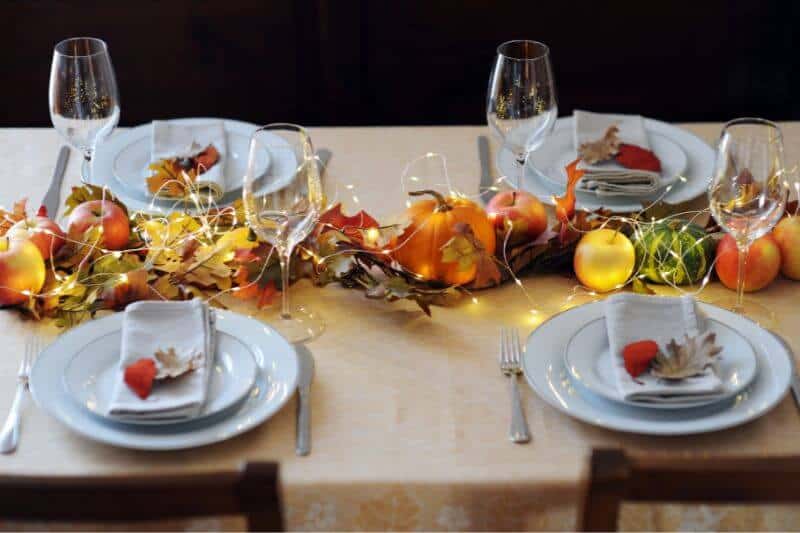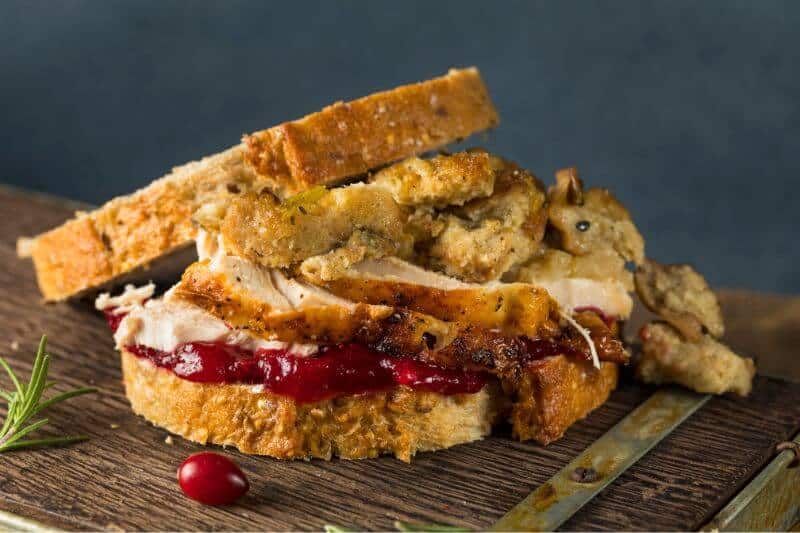How To Successfully Host Thanksgiving Dinner for The First Time
Hosting a Thanksgiving dinner for the first time can feel overwhelming, but with proper planning and organization, you can pull off a memorable and festive celebration. In this article, we’ll guide you through the steps necessary to host a successful Thanksgiving dinner, from planning your menu to setting up the hosting space.
We’ll also share some helpful tips and tricks to make your event run smoothly, so you can focus on enjoying this special time with your loved ones.
Key Takeaways
- Plan for a smooth Thanksgiving dinner, including menu planning and budgeting.
- Properly set up your hosting space for a comfortable and inviting experience.
- Utilize helpful tips and tricks to efficiently manage preparation, cooking, and dealing with leftovers.
Planning Your Thanksgiving Dinner

Organizing a Timeline
To ensure a smooth and stress-free Thanksgiving dinner, it’s crucial to create a timeline.
Begin by listing all the tasks you need to complete, such as shopping for groceries, preparing dishes, and setting the table. Consider using a week-by-week checklist to help you stay organized.
By breaking down tasks into manageable chunks, you’ll have more control over your hosting duties.
Planning a Guest List
When planning your guest list, take into account your available space and resources. Be realistic about the number of people you can comfortably accommodate and ensure you have enough seating and dinnerware for everyone.
Don’t forget to factor in any family traditions or expectations you may have when it comes to your Thanksgiving gathering.
When inviting guests, consider sending out invitations about three weeks ahead of time.
This gives your friends and family plenty of notice, allowing them to make necessary arrangements and provide you with their RSVP.
Considering Dietary Restrictions
Taking into account dietary restrictions is important when hosting your Thanksgiving dinner.
As you’re planning your menu, ask your guests if they have any allergies, intolerances, or preferences.
Adapt your dishes or provide alternative options for those with special dietary needs, such as gluten-free, vegetarian, or vegan options.
Remember, being aware of your guests’ dietary restrictions not only shows thoughtfulness but also ensures everyone can enjoy the meal you’ve worked hard to prepare.
With these steps and a friendly attitude, you’re well on your way to hosting a successful first-time Thanksgiving dinner.
Menu Planning

Choosing the Main Course
When hosting your first Thanksgiving dinner, picking the perfect main course is essential. In most cases, turkey is the go-to protein for this holiday.
However, you can also consider alternatives such as ham, roast beef, or a vegetarian option like stuffed squash.
When selecting your turkey, be sure to choose the right size for your guest count, and don’t forget to buy the turkey in advance to avoid the last-minute rush.
Picking the Side Dishes
To complement your main course, you’ll need an array of delicious side dishes to satisfy your guests. Traditional options include:
- Mashed potatoes
- Stuffing or dressing
- Cranberry sauce
- Green beans
- Sweet potato casserole
Get creative and add a twist to these classics or introduce your own unique sides to the Thanksgiving menu.
Just ensure a mix of flavors and textures that blend well with the main course.
Planning Appetizers and Desserts
Appetizers are a great way to welcome your guests and get their appetites ready for the feast. You could serve a cheese and fruit platter, a variety of dips, or bite-sized finger foods.
Keep it simple and easy to prepare, so you can focus on the main meal.
When it comes to dessert, the all-time favorite is, of course, pumpkin pie. However, you can offer other tasty options such as apple pie, pecan pie, or even a seasonal fruit crisp.
The key is to have a sweet ending to your Thanksgiving meal.
Including Beverages

A well-rounded Thanksgiving dinner should include a variety of beverages to suit your guests’ preferences.
Offer non-alcoholic options like water, sparkling cider, and soda, as well as a few holiday-inspired cocktails or wine choices for the adults.
Don’t forget to have coffee and tea available for those who enjoy a warm beverage with their dessert.
With careful planning and preparation, you can create the ideal Thanksgiving menu that both you and your guests will love.
Budget And Purchasing
Planning a Budget
Hosting a Thanksgiving dinner for the first time can be both exciting and challenging.
One of the essential aspects to consider is your budget. To ensure you don’t overspend, begin by setting a budget based on your guest list.
Here are some helpful steps to plan your budget:
- List all the items you’ll need: This includes perishables, non-perishables, and decorations.
- Estimate the cost of each item: Research average prices at your local grocery store or online.
- Add up the estimates: This will give you a good idea of your total expenses.
- Adjust as needed: If your budget seems too high, look for cost-saving opportunities without sacrificing quality.
- Track your spending: As you start purchasing items, be sure to keep track of your spending to avoid going over budget.
Grocery Shopping
Once you’ve established your budget, it’s time to go grocery shopping. Here are some tips to help you shop effectively and save money:
- Shop early: Don’t wait until the last minute to buy perishables, as this may lead to higher prices and limited options. Keep your eye on sales and promotions weeks before Thanksgiving, especially for non-perishable items.
- Buy in bulk: If you’re expecting a large guest list, purchasing items in bulk can help you save money. However, be mindful of the shelf life of perishable items.
- Stick to your list: It may be tempting to impulsively buy extra items when shopping, but staying true to your list will help you stay within budget.
- Compare prices: Before making a purchase, compare prices at different stores to ensure you’re getting the best deal possible.
- Consider store brands: Opting for store-branded products instead of name brands may save you money without compromising on quality.
By following these tips to plan your budget and undertake your grocery shopping, your first Thanksgiving dinner should be a memorable and enjoyable experience for both you and your guests.
Preparation and Cooking
Preparing the Kitchen
Before you begin, make sure your kitchen is clean and well-organized.
Arrange the necessary utensils, including a roasting pan, baking sheets, casserole dishes, and an instant-read thermometer.
Gather all the ingredients you’ll need for the main course, side dishes, and desserts. This will make the cooking process smoother and more enjoyable.
Cooking the Main Course
Roasting is a popular method for preparing the Thanksgiving turkey. Start by preheating your oven to the appropriate temperature.
Place the turkey in a roasting pan with a rack to allow for even cooking. You can also use a slow cooker to cook a smaller turkey or turkey breast.
This method helps retain the moisture and tenderness of the meat.
- Monitor the temperature of the turkey using an instant-read thermometer.
- To ensure the turkey is cooked to perfection, check the internal temperature in the thickest part of the thigh, which should reach 165°F (74°C).
- Once your turkey is cooked, allow it to rest for 20-30 minutes before carving.
This resting period lets the juices redistribute, making it easier to carve and resulting in a more flavorful and tender dish.
Cooking Side Dishes and Desserts
With side dishes, choose a mix of options to complement your main course.
Some popular Thanksgiving side dishes include mashed potatoes, green bean casserole, and stuffing.
To save time and oven space, consider preparing some side dishes in a slow cooker or on the stovetop.
You can also prepare sides that can be served chilled or at room temperature, such as salads and relishes.
Don’t forget about the dessert! Traditional Thanksgiving desserts, like pumpkin pie and pecan pie, can be baked ahead of time to save yourself from stress on the big day.
Be creative with your dessert offerings and add a personal touch to your first Thanksgiving dinner.
Remember to keep a friendly tone during your preparation and cooking process.
After all, hosting Thanksgiving for the first time is a fantastic opportunity to create lasting memories with your loved ones. Enjoy the experience and remember to have fun!
Setting Up The Hosting Space
Cleaning the House
A clean and welcoming environment is essential when hosting Thanksgiving dinner for the first time.
To make the process easier, start cleaning a few days before the event. Focus on decluttering common areas, such as the living room and dining room.
Additionally, pay attention to the kitchen and the entrance, as these areas will see the most traffic during the event.
Do not forget to clean the bathrooms that your guests will use, ensuring there is enough toilet paper, soap, hand towels, and other supplies.
A clean and well-stocked bathroom will make your guests feel comfortable.
Setting the Table

Table setting plays a pivotal role in creating a warm and inviting atmosphere. Begin by selecting a tablecloth and coordinating napkins, which can be either simple or elaborate depending on your personal style.
If you are short on space, consider using creative solutions like folding tables or even barstools as seating options.
When it comes to table settings, make sure to include the following elements:
- Plates and flatware: Arrange the dinner plates, salad plates, forks, knives, and spoons in the proper order.
- Glasses: Place water glasses and wine glasses at the top right corner of each place setting.
- Napkins: Fold the napkins and place them either on the dinner plates or to the left of the forks.
- Place cards: Personalize your table with place cards for an extra touch of thoughtfulness. This can also help guide guests to their seats.
Feel free to add seasonal decorations, such as fall leaves, small pumpkins, or candles, to enhance the ambiance. Remember, the goal is to create a cozy and inviting dining experience for your guests while keeping it stress-free for yourself.
Hosting Tips and Tricks
Handling Overnight Guests
Having family over for Thanksgiving is always enjoyable, but hosting overnight guests can sometimes be a challenge.
To make their stay comfortable, ensure you provide clean linens and towels. Set up a designated sleeping area with cozy blankets and pillows.
Clear out some closet or dresser space for your guests’ belongings.
Additionally, stock the bathroom with toiletries and let your guests know where to find necessities like extra towels and toilet paper.
Make-Ahead Advices
Preparing food in advance can significantly reduce stress on Thanksgiving Day.
Opt for make-ahead recipes that can be refrigerated or frozen, such as pies, casseroles, and side dishes.
Another time-saving tip is to prep ingredients like chopped vegetables and measured spices a few days before Thanksgiving.
This can help streamline your cooking process and save valuable time on the big day.
- Make a cooking timeline
- Freeze or refrigerate some dishes
- Prep ingredients in advance
Hosting Essentials
To create a stress-free Thanksgiving, it’s essential to plan and prepare in advance. Start by creating a menu and a shopping list, considering any dietary restrictions and allergies of your guests.
Organize your kitchen tools and utensils, such as roasting pans, serving platters, and carving knives, before the big day.
Keep your table settings simple and classic to focus on the delicious food and invaluable family time.
Don’t forget to allocate tasks to family members and guests. This can include setting the table, decorating, or heating up dishes.
Remember to chill wine quickly by wrapping it in a damp towel and placing it in the freezer for 10 to 15 minutes, in case you need it before the guests arrive. Lastly, enjoy the process of hosting your first Thanksgiving, and keep in mind that it’s all about spending time with your loved ones.
Dealing with Leftovers

Storing Leftovers
After enjoying a wonderful Thanksgiving feast, you’ll likely find yourself with plenty of leftovers, including turkey. To store them properly, first cool them down, and then wrap the items tightly in foil or plastic wrap.
Store leftovers in airtight containers, which will help keep them fresh and prevent cross-contamination.
For turkey and other meats, you can separate them into smaller portions and freeze them for longer storage. It’s a good idea to label your containers with a date, so you know when the leftovers were stored.
Always remember to refrigerate leftovers within two hours of cooking to ensure food safety.
Reheating and Repurposing Leftovers
When it’s time to reheat leftovers, make sure to do it correctly. For turkey and other meats, use a meat thermometer to check their internal temperature (165°F to be safe).
You can reheat leftovers in the oven or microwave, but ensure even heating by stirring them occasionally.
Get creative with repurposing your Thanksgiving leftovers by making new meals. Turkey can be used in soups, sandwiches, salads, and casseroles, making it an incredibly versatile ingredient.
Consider turning your remaining turkey into a delicious potpie or transforming your leftover stuffing into a tasty breakfast hash.
There are countless ways to get the most out of your Thanksgiving leftovers, allowing you to enjoy the flavors of this festive meal for days.

Frequently Asked Questions
What is the best way to plan a Thanksgiving menu?
When planning your Thanksgiving menu, it’s essential to consider your guests’ needs and preferences.
Create a balanced mix of traditional dishes with a few unique recipes. Don’t forget to include options for those with dietary restrictions, like vegetarian, gluten-free, or sugar-free alternatives.
Consult reliable recipes or gather ideas from family and friends. Plan your meal ahead of time and make a shopping list to ensure you have all the necessary ingredients.
What should I consider when hosting a large group?
When hosting a large group, first determine the number of guests and available space.
Ensure adequate seating, plates, utensils, and glassware.
Adjust your recipes to serve a larger quantity and consider serving the meal buffet style to simplify the process.
It’s also helpful to delegate tasks, like setting the table or making specific dishes, to friends and family members.
How can I organize a Thanksgiving potluck?
Organizing a Thanksgiving potluck can help take the pressure off the host. Decide on a menu and assign various dishes to guests based on their culinary skills and preferences.
Ensure a balance of appetizers, main courses, sides, and desserts. Don’t hesitate to ask your guests to bring specific items or assist with setting up, serving, or cleaning up.
What are some tips for timing a Thanksgiving dinner?
Timing a Thanksgiving dinner can be challenging, but with proper planning, it’s manageable. Determine which dishes can be made ahead of time and what needs to be cooked on the day.
Create a schedule for the day, factoring in prep time, cooking times, and resting periods.
Coordinate oven usage, and remember to allow ample time for the turkey to cook and rest before serving.
What essential supplies are needed to host Thanksgiving?
To host Thanksgiving, be sure to have enough plates, utensils, glassware, and serving dishes for all guests. Invest in some oven-to-table cookware to save on cleaning.
Additionally, stock up on essentials like aluminum foil, parchment paper, plastic wrap, and storage containers for leftovers.
Consider renting or borrowing additional chairs, tables, or linens if needed.
What are some common mistakes to avoid when hosting Thanksgiving?
Avoid common Thanksgiving hosting mistakes like waiting until the last minute to plan, not delegating tasks, and not considering guests’ dietary needs.
Also, make sure the turkey is completely thawed before cooking, and don’t overstuff it as that can cause uneven cooking.
Double-check your cooking times-temperature settings for each dish and be mindful of oven space.
Lastly, try to remain flexible and enjoy the day with loved ones.



